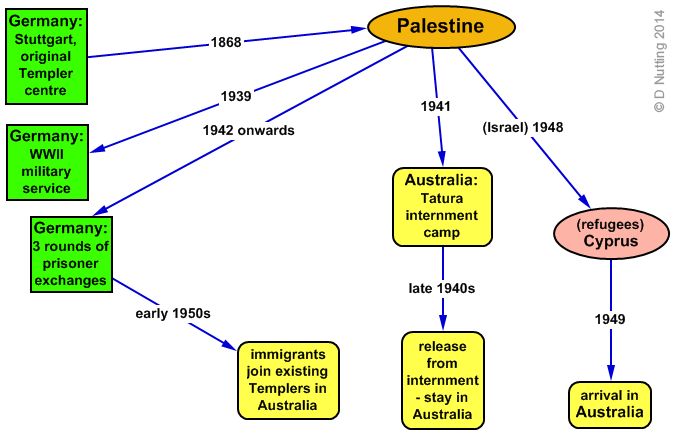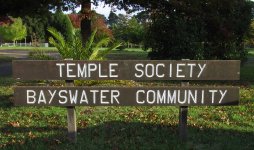![]()
![]() Historical
background of the Templer colonies
Historical
background of the Templer colonies
![]() Templer
life in Palestine
Templer
life in Palestine
![]() Departure
for Australia - Why did the German Templers have to leave Palestine?
Departure
for Australia - Why did the German Templers have to leave Palestine?
In 1917-18 during the First World War the Turks were driven out of Palestine by the army of the British General Allenby. In 1922 the League of Nations (an earlier form of today's United Nations) gave Britain a mandate to govern Palestine.
During the 1930s Palestine-Germans of military service age were required to go to Germany to do compulsory military training, as they were German citizens, and benefited from services and protection provided to them by a German consulate in Palestine, even though they were not born in Germany. In August 1939 all Palestine-German men who had done training in Germany or who were of military service age received orders to go to Germany and report to the armed forces. About 60 German settlers who were visiting Germany when the war broke out were not allowed to return to their settlements in Palestine.
After the war broke out, the British Mandate government turned the German farming settlements of Sarona, Wilhelma, Betlehem and Waldheim into large internment camps. All of the Germans left in Palestine were moved into these camps except for the remaining men of military age. Those men were placed in a Prisoner Of War camp at Acre. Within these internment camps, surrounded by barbed wire, the Palestine-Germans were allowed to move freely and carry out farming activities to produce food.
When General Rommel won a series of important battles in the North African desert, the British authorities in Palestine sent the younger Templer families to Australia, where most of them were interned in the Tatura camp in Victoria.
During the war there were three prisoner exchanges between Germany and Britain. People in Palestine of German nationality (mainly women and children) were exchanged for Jews in Germany, most of whom were in concentration camps. Some Palestine-Germans were keen to be part of this exchange, in order to be able to see their menfolk when they were back in Germany on leave from the armed forces. Other women were not keen to go to Germany and felt that it was their duty to their husbands to stay on their property in Palestine, rather than abandon it. Thanks to the loyalty of their Arab employees these women were still able to run their farms despite the difficult conditions.
At the end of the war the internment in Palestine ended, but the four camps were closed off and guarded by the British authorities in order to protect the Germans from Jewish extremists. Increasingly after 1945 Jewish groups in Palestine demanded that the Allies expel German citizens. The Allies did not want to send the Templers to Germany because Germany was in ruins and had a huge refugee problem already. For many of the Templars remaining in Palestine Germany was not their home anyway, and their relatives and friends that had been sent to Tatura in 1941 encouraged them to come to Australia. In 1948 there was a violent attack on the Waldheim settlement, and the Templers had to flee to the island of Cyprus, where they spent nearly a year. A judge of the Australian High Court investigated the background of the Templers and concluded that they would be very reliable and productive immigrants. He wrote: "In general, they are practical, morally sound and peaceful people." The British Government and the Australian Government signed an agreement that allowed the remaining Germans in Palestine to come to Australia. The new state of Israel paid compensation to them for their former assets in Palestine.

Above: How the Templers came to Australia
Templer community centres were established at Boronia (outer eastern suburb of Melbourne) in 1957, at Bayswater (near Boronia) and at Meadowbank (Sydney) in 1961, and at Bentleigh-Moorabbin (Melbourne) in 1965. There is also a Templer community in Tanunda, SA. The Templer community at Bayswater is particularly large. Haering Street in Boronia is named after the Häring family, who were internees at Tatura, and Wilhelma Avenue in Bayswater is named after the Templer settlement in Palestine. Beilharz Road in the country at Ravenswood, near Bendigo, is named after another Tatura internee family who settled there.
 |
 |
The Templers also established at Bayswater the aged-care home Tabulam for German-speakers. The architect for this entire complex was Willy Blaich, a Templer.
You can read Werner Blaich's Story of his experiences. He was born in Palestine, was interned with his family at Tatura and stayed here. (PDF file, 51Kb - No Adobe Acrobat?)
Homepage of the Temple Society in Australia
See also Sauer, Paul. 1991. The Holy Land Called - the Story of the Temple Society. Temple Society of Australia, Melbourne. Translation of Uns rief das Heilige Land, Konrad Theiss Verlag, Stuttgart 1985.
| Top | Back
| Chronology | Issues
| Students | Site Map |
auf Deutsch |
| Primary Sources (in German) | Bibliography
| Search |
German Australia © D. Nutting 2001